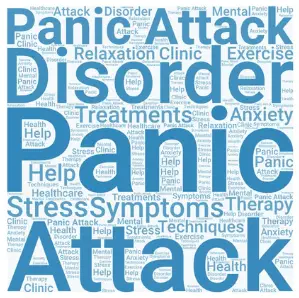Panic attacks can be frightening and can even result in physical symptoms. Shortness of breath, chest pain, seizures, and a racing heart are all signs and symptoms of a panic attack. Some people having a panic attack may think they are having a heart attack. So panic attack victims seek medical attention in a hospital emergency room. For some people, the first panic attack occurs when they are in a stressful situation, such as during a stressful time like giving birth to a baby.

What is a Panic Attack?
First, you must understand the nature of a panic attack. A panic attack is a temporary state of mental tension. Sudden and intense feelings of fear are common characteristics of a panic attack. Panic attack sufferers should remain calm and stay in the exact location since leaving will only create fear of the same place in the future. Then, find an object or a scene to focus on and describe it to yourself. Focusing on positive images, such as a peaceful place, is also helpful in relieving a panic attack.
When faced with danger (like with a panic disorder), our autonomic nervous system triggers physiological changes. These changes brought on by panic disorders, such as heart rate and breathing, are triggered by the release of chemicals like adrenaline. Blood starts transferring from the heart to the muscles. When the body triggers the flight-or-fight response without a real threat, it triggers a panic attack. For this reason, panic attacks can happen even in public settings.
What Does a Panic Attack Feel Like?
When faced with danger, our autonomic nervous system activates, producing a series of chemicals that trigger physiological changes. These chemicals, such as adrenaline, cause our heart rate to increase, blood to shift from our heart to our muscles, and more. But, this same physiological response can also occur when we are unaware of the danger, such as watching television. In such a case, we are likely to experience a panic attack.
One of the most common physical symptoms of a panic attack is excessive trembling. Panic attack symptoms may seem like a heart problem, but it is not. You should seek medical care immediately if you experience these panic attack symptoms. If it persists, you must rule out any underlying cardiac conditions. A doctor can do tests and ask questions to help determine whether the chest discomfort is heart-related or caused by an anxiety attack. Other symptoms of a panic attack include stomach pain and nausea. This panic attack symptom is a normal response to adrenaline.
Rolling Panic Attacks
Rolling panic attacks are different from regular panic attacks. These may last for days or even weeks at a time. The panic attack symptoms may come and go, but the feeling of anxiety and fear remains. Rolling panic attacks can be debilitating. Rolling panic attack disorders can prevent people from going to work or leaving the house. If you are experiencing a rolling panic attack, it is vital to seek professional help. The hotline 988 has been made available to help with panic disorders.
Silent Panic Attacks
Silent panic attacks are a type of panic attack that can occur without any noticeable symptoms. Many people with silent panic attacks don’t even realize they have one until after it’s over.
Silent panic attacks can cause a great deal of anxiety and fear and can be very debilitating. Silent panic attacks may not have any physical symptoms. But people who experience them often feel as panicked as those who have traditional panic attacks.
If you think you may have Silent panic attacks, you must see a doctor or mental health professional. He can rule out any other possible causes of your symptoms. Silent panic attacks are treatable, and there are many effective treatments available. You can learn to manage your Silent panic attacks with proper medical treatment and live a whole, enjoyable life.
What does an anxiety attack feel like?
Anxiety attacks can feel like a sudden, overwhelming feeling of fear or dread. These physical symptoms can go with mental symptoms such as racing thoughts, an inability to focus, and feelings of impending doom. You may also feel heart palpitations, shortness of breath, sweating, and dizziness. Anxiety attacks can vary in intensity and duration but last for a few minutes.
Panic Attack Disorder
The exact causes of panic attack disorder are unclear, but the first one generally occurs during a stressful period. After the first attack, anxiety over future attacks often builds. But not all people who experience these episodes develop the disorder. This depends on their personality and baseline anxiety levels. Some people can be free of panic attacks for months or even years. The good news is that hypnotherapy is a viable option for treating panic disorder.
Symptoms of panic attacks are like those of other illnesses. People often mistake the symptoms of a panic attack for the symptoms of a severe physical ailment. But, if panic attacks continue for more than 20 minutes, they may have a more severe condition. Symptoms can also occur during daily activities, like watching television. In these cases, you should seek professional help and follow the prescribed treatment plan. The sooner you get treatment for panic attack disorder, the sooner you can find relief.
Panic Attacks and Panic Disorders
Panic Attacks and Panic Disorder are two different things. Panic disorder is when you have repeated attacks and live in fear of them happening. But a panic attack is a one-time event. Panic disorder is more severe. It can lead to avoidance of certain situations or places. It can also create significant disruptions in your life. Certain events or conditions can trigger panic attacks but can also occur without any obvious trigger. Therapies and medication help in the treatment of the panic disorder. Panic attacks are usually treated with self-care and relaxation techniques.
What Causes a Panic Disorder?
There is no one answer to this question, as panic disorder can develop for different reasons in different people of all ages. Yet, some risk factors may make someone more likely to develop panic disorder. They may have a family history of anxiety or depression, experienced a traumatic event, or have used specific substances (such as alcohol or drugs). If you have any of these risk factors, it does not mean that you will develop panic disorder. But it may increase your chances.
If you are experiencing panic attacks or have developed panic disorder, it is vital to seek professional help. This can be in the form of medication to treat panic attack, therapy, or both. Self-care and relaxation techniques may also help manage symptoms.
Panic Attack Symptoms
If you’ve ever experienced a panic attack, you know that they are frightening. Panic attack symptoms can include a racing heart, shortness of breath, chest pain, sweating, shaking, and feeling dizzy or lightheaded. Panic attacks can also cause you to feel like you’re going crazy or about to die.
A specific event or situation often triggers panic attacks. Examples are public speaking or being in a crowded place. But they can also happen without any apparent trigger. Panic attacks usually peak within 10 minutes, but some symptoms may last longer.
Panic disorder is a real and treatable condition that can impact your life. If you have panic disorder, you may have recurrent panic attacks and live in fear of another attack. But with treatment, you can manage your panic disorder and live a healthy, happy life.
Panic Attack Symptoms in Adults!
Panic attack symptoms in adults can vary. Some people may only experience one or two symptoms, while others may experience many more. Panic attack symptoms can also differ from person to person. Some people may experience the same sign at different times.
The most common panic attack symptoms include:
-Heart palpitations or a racing heart
-Shortness of breath or feeling like you can’t breathe
-Sweating
-Shaking
-Chest pain
-Feeling dizzy, lightheaded, or faint
-Nausea or stomach cramps
-Feeling like you’re going to pass out
-Feelings of unreality or detachment from yourself
-Fear of losing control or going crazy
-Fear of dying
If you are experiencing any of these symptoms, it’s important to seek medical help. Panic attacks can be very frightening, but they are not dangerous. You can manage your panic disorder and live a happy, healthy life with proper treatment.
Panic Attack For No Reason
There is no single cause of panic attacks, but several factors can contribute. Panic attacks tend to run in families, so if you have a family member with a panic disorder, you may be more likely to experience panic attacks. Other risk factors for panic attacks include stress, anxiety, and certain medical conditions.
Panic Attack Triggers
While there is no single cause of panic attacks, several things can trigger them. Panic attack triggers can be different for everyone.
Some common panic attack triggers include:
–Stressful life events, such as a death in the family or a job loss
-Anxiety disorder
-Substance abuse
-Certain medical conditions, such as cardiovascular disease or thyroid problems
-Panic disorders
-Phobias
If you are experiencing panic attacks, you must talk to your doctor. They can help you identify any triggers and develop a plan to avoid them.
Panic Attacks While Driving
When you experience a panic attack while driving, you are likely to experience a rapid, shallow breathing pattern, a loss of focus, and a rapid rise in blood pressure. All these symptoms can make driving dangerous and distracting, so finding ways to control your panic while driving is vital. Simple techniques such as alternating between breathing deeply and slowly can help you deal with the physical symptoms of a panic attack while driving.
Anxiety can be a symptom of a deeper problem. Anxiety levels are high in our society because of concerns over the environment and biological conditions. The combination of high anxiety levels and driving can trigger a panic attack. Panic disorder is when a person experiences unpredictable bouts of irrational fear. Panic attacks can occur when driving and are common in people with anxiety disorders. Once diagnosed, you can work to manage your anxiety levels.
Anxiety Attack Symptoms in Females
Anxiety attacks are characterized by a high-stress response and the release of high levels of stress hormones. These hormones enhance the body’s ability to deal with threats. The changes these hormones cause last for a few minutes or up to 30 minutes. Symptoms of anxiety attacks are not specific to women but can be a sign of chronic stress. So, what are the common symptoms of women anxiety attacks? Listed below are some of the most common.
Anxiety Attacks Begin With Anxious Thoughts
Progressive muscle relaxation techniques to treat your anxiety symptoms will help you relax your body and mind, shut off your stress response, and recover from an anxiety attack. Try changing your focus to something pleasant, such as a picture or a song. Spending more time on the object will also help your body and mind become calmer. Try meditation. Exercise regularly. The attack will end when the hormones run out and you no longer feel stressed.
